英语人教版五年级下册inonat介词用法.
- 格式:pdf
- 大小:1.44 MB
- 文档页数:10
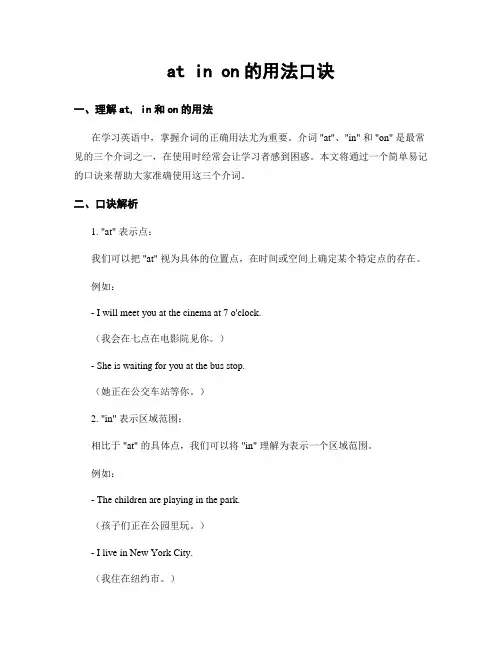
at in on的用法口诀一、理解at, in和on的用法在学习英语中,掌握介词的正确用法尤为重要。
介词 "at"、"in" 和 "on" 是最常见的三个介词之一,在使用时经常会让学习者感到困惑。
本文将通过一个简单易记的口诀来帮助大家准确使用这三个介词。
二、口诀解析1. "at" 表示点:我们可以把 "at" 视为具体的位置点,在时间或空间上确定某个特定点的存在。
例如:- I will meet you at the cinema at 7 o'clock.(我会在七点在电影院见你。
)- She is waiting for you at the bus stop.(她正在公交车站等你。
)2. "in" 表示区域范围:相比于 "at" 的具体点,我们可以将 "in" 理解为表示一个区域范围。
例如:- The children are playing in the park.(孩子们正在公园里玩。
)- I live in New York City.(我住在纽约市。
)3. "on" 表示面:与前两者不同,我们可以将 "on" 看作是一个面的描述,它表达了事物所处于某个表面上。
例如:- There is a book on the table.(桌子上有本书。
)- He cut his finger on the knife.(他刀子上割伤了手指。
)三、更多具体用法示例1. at的用法:- I have a meeting at 9 o'clock.(我九点有一个会议。
)- She is waiting for you at the front door.(她在门口等你。
)- We usually have lunch at school.(我们通常在学校吃午饭。
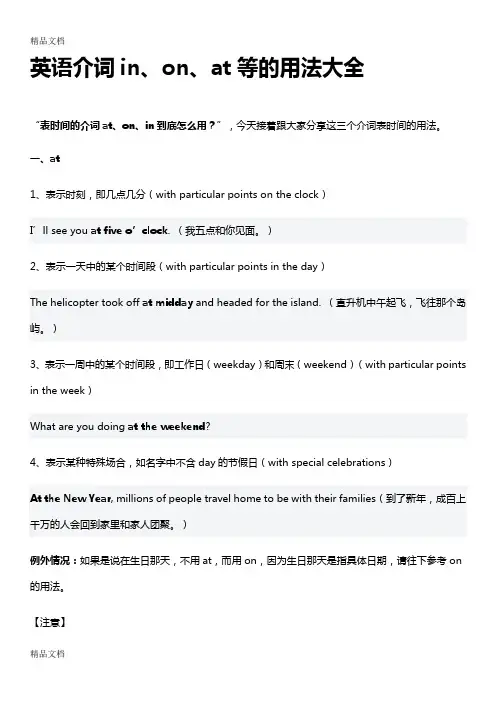
英语介词in、on、at等的用法大全“表时间的介词at、on、in到底怎么用?”,今天接着跟大家分享这三个介词表时间的用法。
一、at1、表示时刻,即几点几分(with particular points on the clock)I’ll see you at five o’clock. (我五点和你见面。
)2、表示一天中的某个时间段(with particular points in the day)The helicopter took off at midday and headed for the island. (直升机中午起飞,飞往那个岛屿。
)3、表示一周中的某个时间段,即工作日(weekday)和周末(weekend)(with particular points in the week)What are you doing at the weekend?4、表示某种特殊场合,如名字中不含day的节假日(with special celebrations)At the New Year, millions of people travel home to be with their families(到了新年,成百上千万的人会回到家里和家人团聚。
)例外情况:如果是说在生日那天,不用at,而用on,因为生日那天是指具体日期,请往下参考on 的用法。
【注意】如果是用what time来提问,what time前面一般不用at。
如:What time are you leaving? (你几点走?)但是在口语中也可以这么问:At what time are you leaving?二、on1、用在日期前(with dates)We moved into this house on 2 October 1997. (我们是1997年10月2日搬进这栋房子的。
)2、用在星期的单数前(with a singular day of the week to refer to one occasion)I’ve got to go to London on Friday. (我周五就到伦敦了。
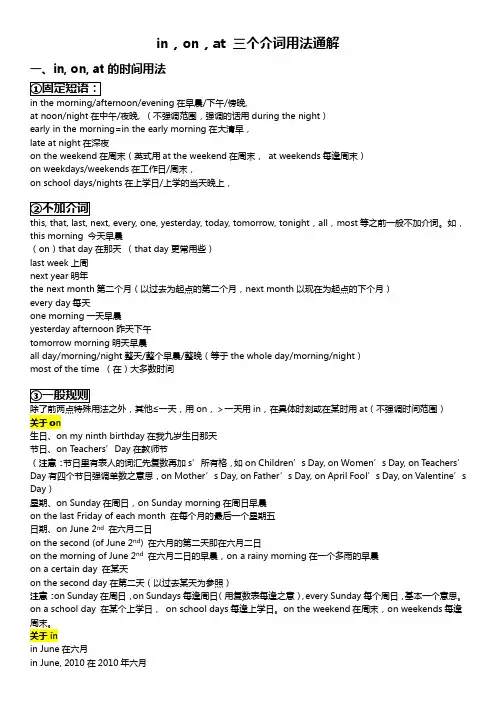
in,on,at 三个介词用法通解一、in, on, at的时间用法在早晨/下午/傍晚,at noon/night在中午/夜晚, (不强调范围,强调的话用during the night)early in the morning=in the early morning在大清早,late at night在深夜on the weekend在周末(英式用at the weekend在周末,at weekends每逢周末)on weekdays/weekends在工作日/周末,on school days/nights在上学日/上学的当天晚上,,all,most等之前一般不加介词。
如,this morning 今天早晨(on)that day在那天(that day更常用些)last week上周next year明年the next month第二个月(以过去为起点的第二个月,next month以现在为起点的下个月)every day每天one morning一天早晨yesterday afternoon昨天下午tomorrow morning明天早晨all day/morning/night整天/整个早晨/整晚(等于the whole day/morning/night)most of the time (在)大多数时间除了前两点特殊用法之外,其他≤一天,用on,>一天用in,在具体时刻或在某时用at(不强调时间范围)关于on生日、on my ninth birthday在我九岁生日那天节日、on Teachers’Day在教师节(注意:节日里有表人的词汇先复数再加s’所有格,如on Children’s Day, on Women’s Day, on Teachers’ Day有四个节日强调单数之意思,on Mother’s Day, on Father’s Day, on April Fool’s Day, on Valentine’s Day)星期、on Sunday在周日,on Sunday morning在周日早晨on the last Friday of each month 在每个月的最后一个星期五日期、on June 2nd在六月二日on the second (of June 2nd) 在六月的第二天即在六月二日on the morning of June 2nd在六月二日的早晨,on a rainy morning在一个多雨的早晨on a certain day 在某天on the second day在第二天(以过去某天为参照)注意:on Sunday在周日,on Sundays每逢周日(用复数表每逢之意),every Sunday每个周日,基本一个意思。
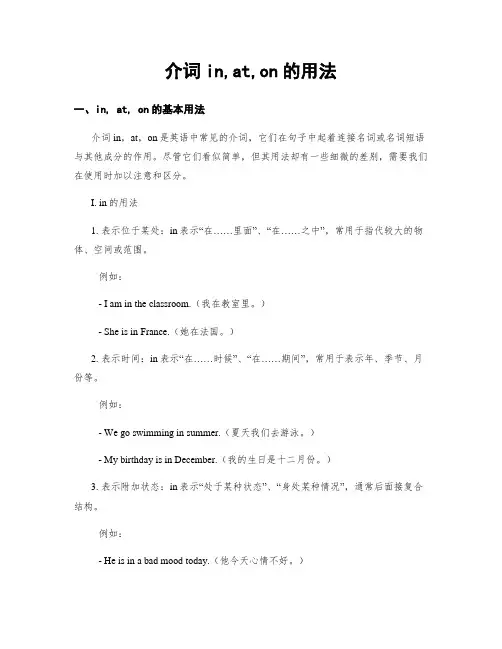
介词in,at,on的用法一、in, at, on的基本用法介词in,at,on是英语中常见的介词,它们在句子中起着连接名词或名词短语与其他成分的作用。
尽管它们看似简单,但其用法却有一些细微的差别,需要我们在使用时加以注意和区分。
I. in的用法1. 表示位于某处:in表示“在……里面”、“在……之中”,常用于指代较大的物体、空间或范围。
例如:- I am in the classroom.(我在教室里。
)- She is in France.(她在法国。
)2. 表示时间:in表示“在……时候”、“在……期间”,常用于表示年、季节、月份等。
例如:- We go swimming in summer.(夏天我们去游泳。
)- My birthday is in December.(我的生日是十二月份。
)3. 表示附加状态:in表示“处于某种状态”、“身处某种情况”,通常后面接复合结构。
例如:- He is in a bad mood today.(他今天心情不好。
)- The company is in financial trouble.(公司陷入了财务困境。
)II. at的用法1. 表示位置:at表示“在……地方”、“在某处”,常用于指代较小范围的地点、位置或具体场所。
例如:- She is waiting for you at the bus stop.(她在公交车站等你。
)- I will meet you at the cinema.(我会在电影院见你。
)2. 表示时间:at表示“在……具体时间点”,通常用于某一具体时刻、钟点或时间段。
例如:- The meeting starts at 9 a.m.(会议在上午九点开始。
)- I usually have dinner at 6:30 p.m.(我通常六点半吃晚饭。
)3. 表示动作进行的状态:at表示“正在进行某个动作”、“忙着做某事”,通常用于表示举止、动作进行中。
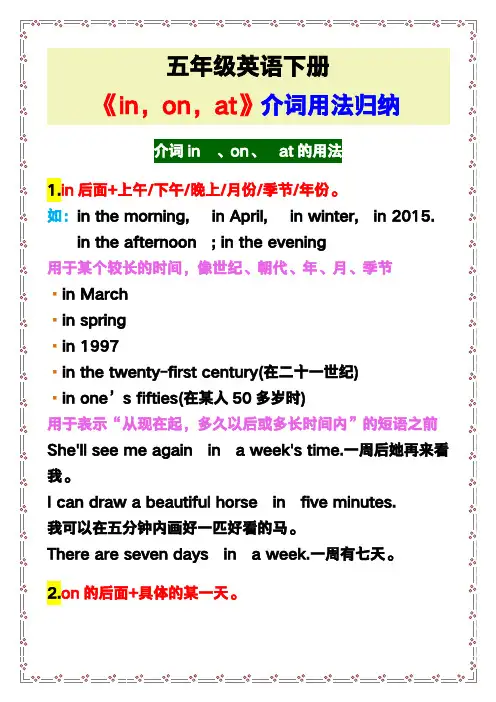
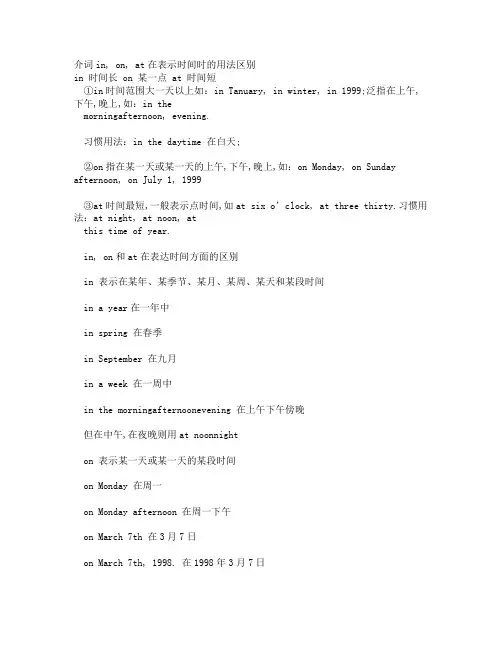
介词in, on, at在表示时间时的用法区别in 时间长 on 某一点 at 时间短①in时间范围大一天以上如:in Tanuary, in winter, in 1999;泛指在上午,下午,晚上,如:in themorningafternoon, evening.习惯用法:in the daytime 在白天;②on指在某一天或某一天的上午,下午,晚上,如:on Monday, on Sunday afternoon, on July 1, 1999③at时间最短,一般表示点时间,如at six o’clock, at three thirty.习惯用法:at night, at noon, atthis time of year.in, on和at在表达时间方面的区别in 表示在某年、某季节、某月、某周、某天和某段时间in a year在一年中in spring 在春季in September 在九月in a week 在一周中in the morningafternoonevening 在上午下午傍晚但在中午,在夜晚则用at noonnighton 表示某一天或某一天的某段时间on Monday 在周一on Monday afternoon 在周一下午on March 7th 在3月7日on March 7th, 1998. 在1998年3月7日on the morning of March 7th, 1998. 在1998年3月7日上午at 表示某个具体时刻;at eight o’clock 在8点钟at this time of the year 在一年中的这个时候at the moment 在那一时刻at that time 在那时注意:在英语中,如果时间名词前用this, last, next 等修饰时,像这样的表示,“在某时”的时间短语前,并不需要任何介词;例如:last month, last week, this year, this week, next year, the next day, thenext year等;1.What’s the weather like in springsummerautumnwinter in yourcountry你们国家春天夏天秋天冬天的天气怎么样in 在年、月、周较长时间内in a week 在里面in the room用某种语言in English 穿着in redon 某日、某日的上下午on Sunday afternoon 在……上面on the desk 靠吃……为生live on rice 关于 a book on Physics〔误〕 We got to the top of the mountain in daybreak.〔正〕 We got to the top of the mountain at day break.〔析〕 at用于具体时刻之前,如:sunrise, midday, noon, sunset, midnight, night;〔误〕 Don't sleep at daytime〔正〕 Don't sleep in daytime.〔析〕 in 要用于较长的一段时间之内,如:in the morning afternoon, 或in the week monthyear. 或 in spring supper autumn winter等等;〔误〕 We visited the old man in Sunday afternoon.〔正〕 We visited the old man on Sunday afternoon.〔析〕 in the morning, in the afternoon 如果在这两个短语中加入任何修饰词其前面的介词都要改为on, 如:on a coldmorning, on the morning of July 14th〔误〕 He became a writter at his twenties〔正〕 He became a writter in his twenties〔析〕这句话应译为:他在20多岁时就成了作家;在某人的一段生活时间段中要用介词in来表示,而在具体岁数时用at来表示;〔误〕 He went to New York to find a job in sixteen years old.〔正〕 He went to New York to find a job at sixteen.〔析〕在具体年岁前用at, 如:at the age of 12, at your age, 等等;〔误〕 We went to swim in the river in a very hot day.〔正〕 We went to swim in the river on a very hot day.〔析〕具体某一天要用介词on, 又如:on New Year's Day〔误〕 I'm looking forward to seeing you on Christmas.〔正〕 I'm looking for ward to seeing you at Christmas.〔析〕在节日的当天用on,而全部节日期间用at,Christmas是圣诞节期间,一般要有两周或更长的时间;〔误〕 I haven't see you during the summer holidays.〔正〕 I haven't seen you since the beginning of the summerholidays.〔析〕 during表示在某一段时间之内,所以一般不与完成时搭配,如:Ivisited a lot of museums during theholiday. 而for表示一段时间,可以用于完成时,如:I haven't see you for a long time. 而through用来表示时间时则为整整,全部的时间;如:It rained through thenight.而since则是表达主句动作的起始时间,一般要与完成时连用;〔误〕 At entering the classroom, I heard the good news.〔正〕 On entering the classroom, I heard the good news.〔析〕 On 加动名词表示一……就;本句的译文应是:我一进入教室就听见这个好消息了;又如:on hearing… 一听见, on arrival一到达就……on表示动作的名词〔误〕 In the beginning of the book, there are some interesting stories.〔正〕 At the beginning of the book, there are some interesting stories.〔析〕 at the begining与at the end都是指某事物的开始与结束部分,均不指时间范围,而in the beginning则是指开始一段时间;in the end=at last是指最终,终于之意;〔误〕 Till the end of next week. I will have finished this work.〔正〕 By the end of next week. I will have finished this work.〔析〕 by 引起的时间状语表示了动作的截止点,其意思为不迟于某一时刻将工作做完,所以主句一般是完成时态;当然可以有将来时态,如:I'll bethere by fiveo'clock.而till则表达其一动作一直持续到某一时刻,但句中的动词一定要用持续性动词,而瞬间的截止性动词应用其否定句式,如:I won'tfinish this work tilluntil next weekend.〔误〕 He came to London before last weekend.〔正〕 He had come to London before last weekend.〔正〕 He came to London two weeks ago.〔析〕 before 一般要与完成时连用,而ago则与一般过去时连用;〔误〕 I have studied English for three years gince I had come here.〔正〕 I have studied English for three years since I came here.〔析〕 since用来表达主句动作的开始时间,所以其引出的从句中应为过去时,而不能用完成时态〔误〕 I can help you repair this bike. You will get it after two hours.〔正〕 I can help you repair this bike. You will get it in two hours.〔析〕中文经常讲两小时之后来取,两天内会修好,而这个介词在英文中要用in 而不要用after;其原因有二,①after 多用于过去时,如:I arrivedin New York. After three days, I found a job in the bank. ② after加时间是表达一个不确定的时间范围,如:after three days, 即三天之后的哪一天都可以;所以在许诺若干时间内会完成某事时,一定要用介词in;〔误〕 Three days after he died.〔正〕 After three days he died.〔正〕 Three days later he died.〔析〕 after 与 later都可以用来表达一段时间之后,但它们所处的位置不同,after 在时间词前,而later在时间词后;〔误〕 She hid herself after the tree.〔正〕 She hid herself behind the tree.〔析〕 after多用来表达某动作之后,所以有的语法书中称它为动态介词,如:I run after him. After finishing myhomework, I went to see a film. 而behind则多用于静态事物之后;〔误〕 There is a beautiful bird on the tree.〔正〕 There is a beautiful bird in the tree.〔析〕树上长出的果实,树叶要用on, 而其他外来的人、物体均要用in the tree.〔误〕 Shanghai is on the east of China.〔正〕 Shanghai is in the east of China.〔析〕在表达地理位置时有3个介词:in, on, to; in表示在某范围之内; on 表示与某地区接壤;to则表示不相接;如:Japan is tothe east of China.〔误〕 I arrived at New York on July 2nd.〔正〕 I arrived in New York on July 2nd.〔析〕 at用来表达较小的地方,而in用来表达较大的地方;at常用于at the school gate, at home, at a bus stop,at the station, at the cinema, at a small village;〔误〕 He lived in No. 3 Beijing Road.〔正〕 He lived at No. 3 Beijing Road.〔析〕在门牌号码前要用at, 并要注意它的惯用法:at the end of the street, at the foot of themountain, at the top of the page;〔误〕 There is a colour TV set at the corner of the hall.〔正〕 There is a colour TV set in the corner of the hall.〔析〕在屋内的角落应用in,而墙的外角用at,如:There is a tree at the corner of the street.〔误〕 This weekend I'll stay in Uncle Wang's.〔正〕 This weekend I'll stay at Uncle Wang's.〔析〕要注意英文的特殊表达法,如:at a tailor's shop 裁缝店=at a tailor's, at the doctor's去看病 at the bookseller's 在书店 at uncle Wang's 在王叔叔家〔误〕 Do you know there is some good news on today's newspaper〔正〕 Do you know there is some good news in today's newspaper〔析〕在报纸上的新闻要用in, 而在具体某一版上,或某一页上则要用on;〔误〕 The school will begin on September 1st.〔正〕 School will begin on September 1st.〔析〕这里的school应看作不可数名词泛指学校的课程,即开学之意;要注意,有些活动场所当表达正在从事该种活动时不要加冠词,如:at table吃饭, When I came to Tom's home, they were at table. 还有: at desk 学习,at work工作 at school 上学, in hospital 住医院 at church 作礼拜如加上定冠词则另有他意,如:at theschool 即在学校工作或办事,in the hospital 即在医院工作或去看望病人;〔误〕 In my way to the station, I bought a newspaper to kill time.〔正〕 On my way to the station, I bought a newspaper to kill time.〔析〕译文为:在去车站的路上我买了份报纸,为的是消磨时光在……的路上应用on one's way…;而 in the way有挡道之意,如:Please move the chair it is in the way;。
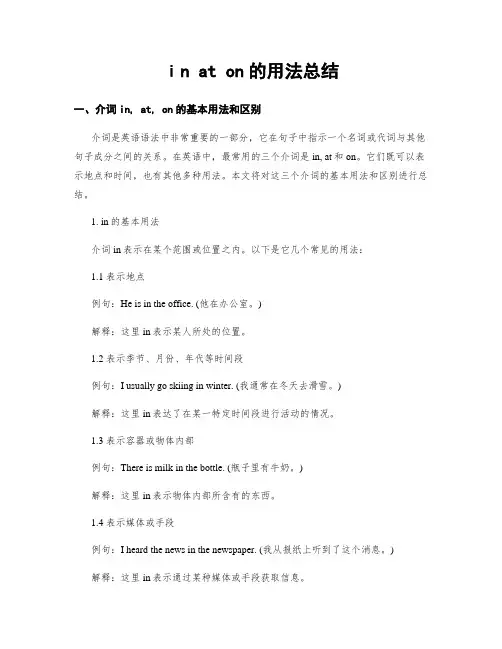
ⅰn at on的用法总结一、介词in, at, on的基本用法和区别介词是英语语法中非常重要的一部分,它在句子中指示一个名词或代词与其他句子成分之间的关系。
在英语中,最常用的三个介词是in, at和on。
它们既可以表示地点和时间,也有其他多种用法。
本文将对这三个介词的基本用法和区别进行总结。
1. in的基本用法介词in表示在某个范围或位置之内。
以下是它几个常见的用法:1.1 表示地点例句:He is in the office. (他在办公室。
)解释:这里in表示某人所处的位置。
1.2 表示季节、月份、年代等时间段例句:I usually go skiing in winter. (我通常在冬天去滑雪。
)解释:这里in表达了在某一特定时间段进行活动的情况。
1.3 表示容器或物体内部例句:There is milk in the bottle. (瓶子里有牛奶。
)解释:这里in表示物体内部所含有的东西。
1.4 表示媒体或手段例句:I heard the news in the newspaper. (我从报纸上听到了这个消息。
)解释:这里in表示通过某种媒体或手段获取信息。
2. at的基本用法介词at表示在特定的位置、时间或事件中。
以下是它几个常见的用法:2.1 表示地点例句:She is waiting for you at the station. (她在车站等你。
)解释:这里at表示某人所处的具体地点。
2.2 表示具体时间点例句:The meeting will start at 9:00 am. (会议将于上午9点开始。
)解释:这里at表示某一特定时间点。
2.3 表示活动例句:They laughed at the joke. (他们笑了起来,因为那个笑话太搞笑了。
)解释:这里at表示活动发生时的情况。
2.4 表示事件或状态例句:He was surprised at the news. (他对这个消息感到惊讶。
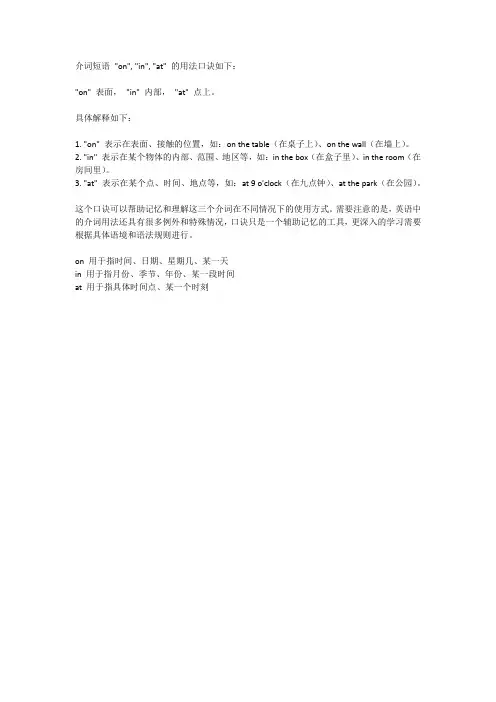
介词短语"on", "in", "at" 的用法口诀如下:
"on" 表面,"in" 内部,"at" 点上。
具体解释如下:
1. "on" 表示在表面、接触的位置,如:on the table(在桌子上)、on the wall(在墙上)。
2. "in" 表示在某个物体的内部、范围、地区等,如:in the box(在盒子里)、in the room(在房间里)。
3. "at" 表示在某个点、时间、地点等,如:at 9 o'clock(在九点钟)、at the park(在公园)。
这个口诀可以帮助记忆和理解这三个介词在不同情况下的使用方式。
需要注意的是,英语中的介词用法还具有很多例外和特殊情况,口诀只是一个辅助记忆的工具,更深入的学习需要根据具体语境和语法规则进行。
on 用于指时间、日期、星期几、某一天
in 用于指月份、季节、年份、某一段时间
at 用于指具体时间点、某一个时刻。
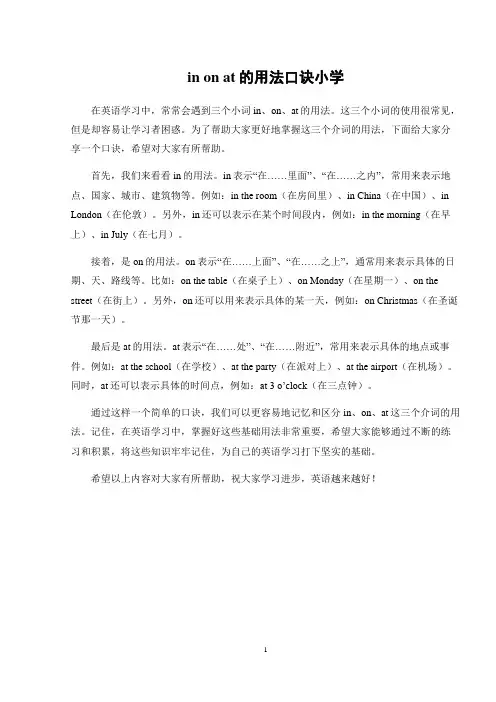
in on at的用法口诀小学在英语学习中,常常会遇到三个小词in、on、at的用法。
这三个小词的使用很常见,但是却容易让学习者困惑。
为了帮助大家更好地掌握这三个介词的用法,下面给大家分享一个口诀,希望对大家有所帮助。
首先,我们来看看in的用法。
in表示“在……里面”、“在……之内”,常用来表示地点、国家、城市、建筑物等。
例如:in the room(在房间里)、in China(在中国)、in London(在伦敦)。
另外,in还可以表示在某个时间段内,例如:in the morning(在早上)、in July(在七月)。
接着,是on的用法。
on表示“在……上面”、“在……之上”,通常用来表示具体的日期、天、路线等。
比如:on the table(在桌子上)、on Monday(在星期一)、on the street(在街上)。
另外,on还可以用来表示具体的某一天,例如:on Christmas(在圣诞节那一天)。
最后是at的用法。
at表示“在……处”、“在……附近”,常用来表示具体的地点或事件。
例如:at the school(在学校)、at the party(在派对上)、at the airport(在机场)。
同时,at还可以表示具体的时间点,例如:at 3 o’clock(在三点钟)。
通过这样一个简单的口诀,我们可以更容易地记忆和区分in、on、at这三个介词的用法。
记住,在英语学习中,掌握好这些基础用法非常重要,希望大家能够通过不断的练习和积累,将这些知识牢牢记住,为自己的英语学习打下坚实的基础。
希望以上内容对大家有所帮助,祝大家学习进步,英语越来越好!1。
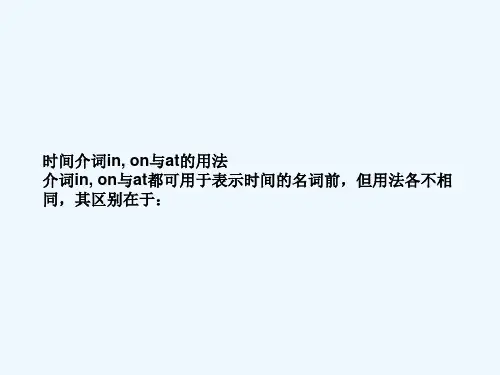
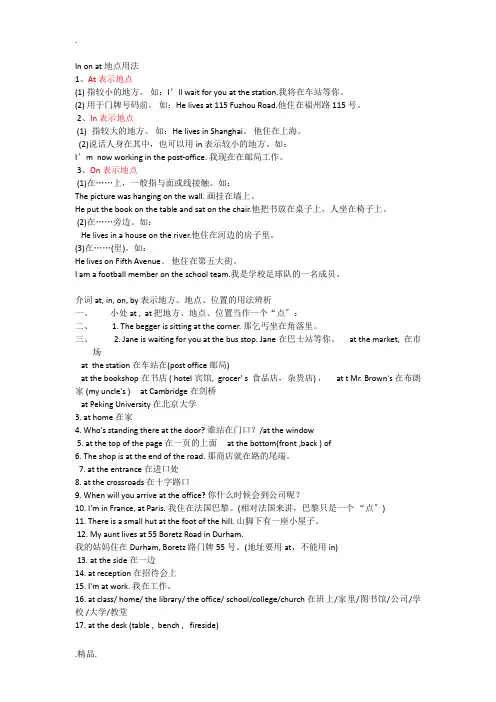
In on at 地点用法1、At 表示地点(1) 指较小的地方。
如:I'll wait for you at the station.我将在车站等你。
(2) 用于门牌号码前。
如:He lives at 115 Fuzhou Road.他住在福州路115号。
2、In 表示地点(1)指较大的地方。
如:He lives in Shanghai。
他住在上海。
(2)说话人身在其中,也可以用in 表示较小的地方。
如:I'm now working in the post-office. 我现在在邮局工作。
3、On表示地点(1)在……上,一般指与面或线接触。
如:The picture was hanging on the wall. 画挂在墙上。
He put the book on the table and sat on the chair.他把书放在桌子上,人坐在椅子上。
(2)在……旁边。
如:He lives in a house on the river.他住在河边的房子里。
(3)在……(里)。
如:He lives on Fifth Avenue。
他住在第五大街。
I am a football member on the school team.我是学校足球队的一名成员。
介词at, in, on, by 表示地方、地点、位置的用法辨析一、小处at , at 把地方、地点、位置当作一个“点〞:二、 1. The begger is sitting at the corner. 那乞丐坐在角落里。
三、 2. Jane is waiting for you at the bus stop. Jane在巴士站等你。
at the market, 在市场at the station在车站在(post office 邮局)at the bookshop在书店 ( hotel宾馆, grocer' s 食品店,杂货店) , at t Mr. Brown's在布朗家 (my uncle's ) at Cambridge在剑桥at Peking University 在北京大学3. at home 在家4. Who's standing there at the door? 谁站在门口?/at the window5. at the top of the page 在一页的上面 at the bottom(front ,back ) of6. The shop is at the end of the road. 那商店就在路的尾端。
介词in, on, at一直是教学中的难点,首先复习一下以前学习过的一般用法:1. at表示\“在......处\”,一般指较小的比较具体的地点。
He isn’t at school.他不在学校。
He is at home. 他在家。
2. in表示\“在......内部;在......里面\”的意思。
What’s in the box? 盒子里有什么?My story book is in the desk.我的故事书在课桌里。
3. on表示\“在某物的上面\”,但两者互相接触。
My books are on that table. 我的书在那张桌子上。
What’s on the bed? 床上是什么?根据不同的情况进行区分at, in, on在表示时间上的区别at常用于具体的时间、中午、夜里等.如:at five o’clock (五点)at noon (中午)at night (夜里)in常用于年、月、上午、下午、晚上、季节等.如:in 2000(2000年)in May (五月)in the morning (早晨/上午)in the afternoon (下午)in the evening (晚上)in spring (春季)on常用于星期、某天、节日等.如:on Sunday (星期日)on October 1st(10月1日)on New Year’s Day (新年)on Monday morning(星期一上午)通过针对性的练习来掌握不同的用法用介词in on at填空______1999 _______9:45 _______noon______the evening _______Monday ______Sunday afternoon ______night ______Children’s Day ______Teachers ’Day ______8 o’clock ______summer _______June_______May ________May15th根据句意用in on at 填空I get up six the morning.We watch TV the evening.We’ll have a party March.I usually eat breakfast 7 o’clock.What’s the box?What will you do Tree Planting Day?。
in和on at的用法一、使用介词in和on描述位置不同的介词可以用来描述物体或人所在的位置。
其中,in 和 on 是最常见的两个介词,它们在描述位置时有着特定的用法和含义。
I. in 的用法1. 表示物体或人在某个范围内:例如:- The book is in the bag.(这本书在包里。
)- He lives in London.(他住在伦敦。
)2. 描述物体或人处于某种状态或情况中:例如:- She is in love with him.(她爱上了他。
)- I am in a hurry.(我很着急。
)3. 表示某个地点、建筑、房间等特定场所:例如:- They are in the park.(他们在公园里。
)- The children are playing in the classroom.(孩子们正在教室里玩耍。
)II. on 的用法1. 表示物体或人位于一个平面或表面上:- The book is on the table.(这本书在桌子上。
)- She put her keys on the desk.(她把钥匙放在桌子上。
)2. 描述物体或人身处交通工具上:例如:- He's on the train to New York now.(他现在正在坐去纽约的火车上。
)- She was on a plane when she received the news.(她在收到消息的时候正在飞机上。
)3. 表示具体日期、某一天或特定的时间点:例如:- The meeting is on Monday.(会议定在周一举行。
)- The concert will be on Christmas Eve.(音乐会将在平安夜那天举行。
)二、深入了解in和on的用法除了基本的位置描述,in和on还可以根据不同的语境有更多特殊用法。
I. on 的特殊用法1. 在计划、日程和表演方面的使用:例如:- We have a meeting on Friday afternoon.(我们星期五下午有个会议。
介词in on at的用法一、in、on和at的基本用法介绍在英语中,介词是连接词与其他成分之间关系的词语,常见的介词有in、on和at。
尽管它们都表示位置、时间或状态等方面的含义,但它们在具体用法上有着明确的区别。
一、介词"in"的用法1. 表示在某个具体位置或范围之内:例如:- She is in the room.(她在房间里。
)- The book is in my bag.(书在我的包里。
)2. 表示成员身份、职业等:例如:- I work in a hospital.(我在医院工作。
)- He is a teacher in a school.(他是一所学校的教师。
)3. 表示以何种方式进行:例如:- We communicate in English.(我们用英语交流。
)- I prefer to travel by train, not in a car.(我更喜欢坐火车旅行,而不是开车。
)4. 用于某些固定短语中:例如:- In my opinion, this movie is boring.(依我之见,这部电影很无聊。
)- In general, people tend to enjoy the summer more than the winter.(总体而言,人们更喜欢夏天而不是冬天。
)二、介词"on"的用法1. 表示对象或人在平面上某一位置:例如:- The book is on the table.(书在桌子上。
)- He is sitting on the chair.(他坐在椅子上。
)2. 表示某个日期或特定的时间点:例如:- I have a meeting on Monday.(我星期一有个会议。
)- The concert starts on 8 o'clock.(音乐会8点开始。
)3. 表示依赖关系、支持以及研究等:例如:- I rely on my friends for support.(我依靠朋友来支持我。
人教PEP英语五年级下册专项复习介词一、介词的定义和用法介词是连接名词、代词或动词与其他词语的虚词,用来表示它们之间的关系。
常见的介词有:in、on、at、with、by、to、from 等。
以下是一些常用介词及其用法:1. in:表示在某个地方、时间或状态中。
in:表示在某个地方、时间或状态中。
- I live in a big city.in a big city.- She goes to school in the morning.in the morning.- He is in good health.in good health.2. on:表示在某个表面、日期或某一天的某个时间。
on:表示在某个表面、日期或某一天的某个时间。
- The book is on the table.on the table.- His birthday is on July 1st.on July 1st.- We usually have a meeting on Monday mornings.on Monday mornings.3. at:表示在某个具体的地点、时间或某一天的某个具体时间。
at:表示在某个具体的地点、时间或某一天的某个具体时间。
- They are waiting for us at the bus stop.at the bus stop.- We have a party at 7 o'clock.at 7 o'clock.- The concert will be held at the stadium.at the stadium.4. with:表示伴随、具有或使用某物。
with:表示伴随、具有或使用某物。
- She went shopping with her friends.with her friends.- He is a man with a beard.with a beard.- Can I have a cup of tea with sugar?with sugar?5. by:表示通过某种方式、由某人完成或表示乘坐交通工具。
in,on,at介词后接时间、地点一. in,on,at 后接地点in 强调“在…里”(空间范围内), 后接的是大地方,例如城市,国家等;at 强调“点”,可翻译成“在…”“在…处”或者“在...旁”,后面接的是小地方,例如门牌号码前,车站,飞机场等;on 强调“在…上”(表面), 表示地点,一般指与面或线有接触in 表示在某个范围之内,没有出这个圈子,比如:in the city在城市里Wangfujing Street is in Beijing. 王府井大街在北京。
in the countryside在农村里Farmers are worming in the field. 农民们正在田间干活。
in the office 在办公室里Our village is in a valley. 我们村儿处在一个山谷里。
in the middle of the river在河的中间on 在…上(表面),表示在某个平面上或与一个面相接触,这一点和 over 与 above 是不同的。
比如:on the cover of the book. 在书的封面上on this menu. 在这菜单上on the way to…在去…的路上There are some boats on the river. 河面上有一些船儿。
They're having fun on the playground.他们正在操场上玩。
on 表在…上或者搭乘, 与 in 区别如下:on a bus 乘巴士,在公汽上 in a bus 在公汽里on a train 乘火车,在火车上 in a train 在火车里on a plane 乘飞机,在飞机上 in a plane在飞机里on a ship乘轮船,在轮船上 in a ship 在轮船里,表达的位置不一样。
at 则表示在某个具体的场所或地点,这一点和用在时间之前一样,都是在一个比较具体的、很小的“点”之前。
inonat差别用法介是英用中的一大,波及面广且用法也灵巧,因此起来特别麻,下边我把一些用的介作了一个小,供以参照。
早、午、晚要用in,at拂晓、子夜、点与分。
年、月、年代、季、周,阳光、灯、影、衣、冒in。
未来in...此后,小at大in。
有形with无形by,言、位、资料in。
特点、方面与方式,心情成用in。
介at和to表方向,攻、地点、、善分。
日子、日期、年代日,礼拜加上早、午、晚,收音、、日on,对于、基、靠、著。
着、、销售、、公、假,成心、支付、相反,准。
特定日和“一⋯⋯就”,on后常接名。
年、月、日加早、午、晚,of以前on代in。
步行、、、玩笑on,cab,carriage用in。
at山脚、口、在目前,速、温、日落、价、核心。
如大概掌握上边介用法口,就不易出。
自然,至于介的尽用法,同形又是及副等内容此篇不。
下边口分例帮助你理解消化。
早、午、晚要用inintheevening在夜晚intheday在白日例:intheafternoon在下午inthemorning在清晨at拂晓、午、夜、点与分atdawnatdaybreak在拂晓候atnight在夜atnoon在正午atmidnight在子夜以上短都不用冠atnineo'clock在9点at8:30seventhirty在8点半athalfpastten在10点半atninefifteen在9点15分attenthirty. 在上午10点30分也能够写成seventofive5点差7分半小以上fiveminutesaftertwo2点过5分attheweekend在周末ataquartertotwo1点45分年、月、年代、季节、周即在“来年”,在“某月”,在“某年某月”但在某年某月某日则用on,在四时,在第几周等都要用in。
例:in1989在1989年in1927在1927年inMarch在三月inApril在四月inDecember1986在1986年12月inJulyl984在1984年7月inthefirstweekofthissemester这学期的第一周inthethirdweek在第三周inspring在春天insummer在夏季inautumn在秋天inwinter在冬季阳光、灯、影、衣、冒in即在阳光下,在灯下,在树阴下,穿衣、着装、冒雨等都要用in。